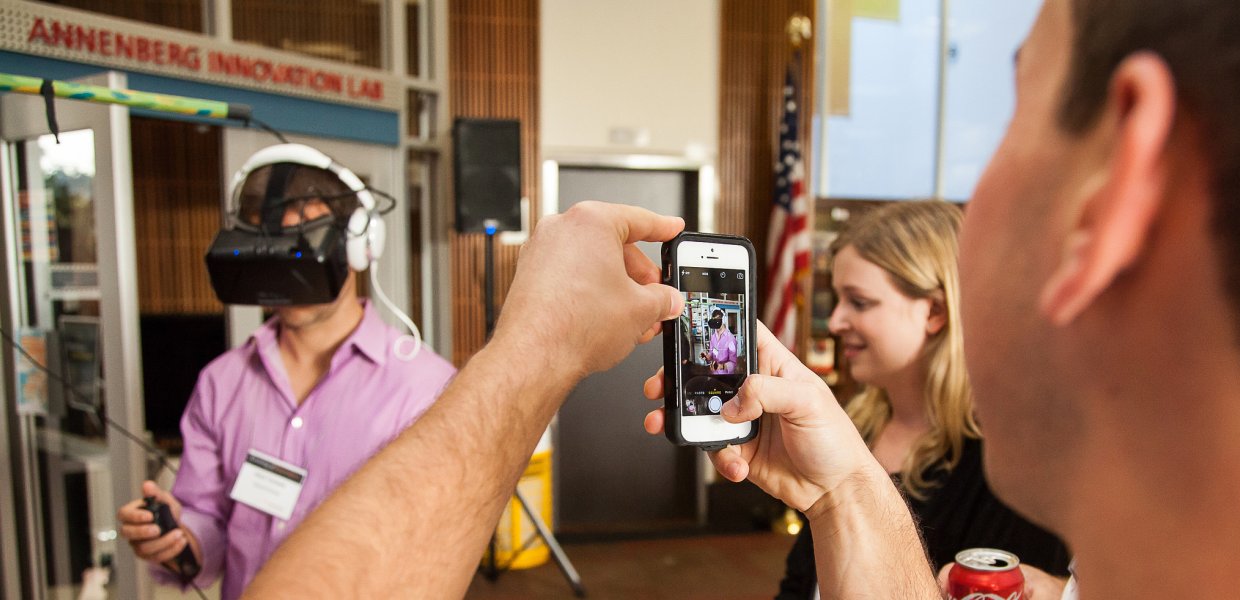For six student startup groups, the Annenberg Innovation Lab's Evening of Innovation is the pinnacle moment of accomplishment after dedicating more than a semester to launching what started for most as just an idea into a viable, working product.
On Thursday, April 16, hundreds of USC faculty, staff and students crowded into the USC Annenberg School’s West Lobby for the second annual collaboration between AIL, Blackstone Launchpad USC and CRUNCH Student Design Challenge.
Now in its fifth year, the CRUNCH Student Design Challenge + Incubator course places selected student entrepreneurs deep in the trenches of an eight-week “startup boot camp,” learning the ins and outs of developing, testing and branding a product from leaders within the AIL and outside mentors with entrepreneurial expertise.
The Evening of Innovation was like a final exam for the students turned business moguls, as teams pitched their ideas to a panel of industry judges for a shot at winning $10,000 in additional funding to get their start up off the ground, and to become the AIL’s startup-in-residence for the following year.
Francesca Smith, research associate at AIL, said judges weighed multiple factors before selecting Alex Zhang and Cole Boyer’s “Prefound,” an online platform that aggregates thrift shops in one central location for shoppers to access, as the winner.
“[Judges looked at] whether [the product] is differentiated in some core way from other players in the market, whether it provides a level of social justice and basically makes the world a better place, whether the teams are really polished and have in some way shown that they really care and put a lot of effort into this product and finally, just that sort of indescribable wow factor,” Smith said.
Other competing teams included Prevail Games, ElemenTerra, HexCare, LOUDER, and Stunt Players.
Each startup focused on alleviating a social issue — strengthening accessibility of healthcare data for physicians, addressing a lack of quality systems to amplify sound and improving mental health, among others.
Attendees were also able to make their voices heard with the Evening of Innovation’s first People’s Choice Award. The winners were Alex Murphy, Rachel Victor, Olivia Chui and Logan Friend, co-founders of Prevail Games — a videogame initiative working to provide survivors of sexual assault with more effective recovery resources.
"With video games present in over 75% of American households, academic studies have begun to show that games can offer much more than just entertainment — they can offer therapeutic benefits as well. However, the therapeutic games used in these studies are unavailable to the average consumer,” Murphy said of why “Bridge to Solas” works to bridge this gap.
Hunter Crowder, CEO of one of the competing CRUNCH groups and a USC Annenberg communication student, attributes his project’s success to the hands on leadership he experienced throughout the course.
“[Stunt Players] has evolved immensely. Through Blackstone and CRUNCH, there is a much greater expectation for it to be great,” Crowder said of his company looking to reshape the way stunt performers get work in Hollywood. “They really helped guide me through the technical, business related aspects that I just didn’t know anything about.”
Geoffrey Long, research fellow and director at the lab, agreed that harnessing the power of innovation through programs like CRUNCH is crucial for college students to succeed in the real world.
“Thinking innovatively is an especially important skill for students to learn in college because the world is always changing, and students need to not only learn how to change along with it, but to get out in front of it and help lead and manage that change,” Long said.
Beyond the competition, though, Long says the Evening of Innovation served as a final masterpiece of the huge breadth of work focused on at the lab and even sparks opportunities for new ideas and collaboration moving forward.
“If the core of innovation is seeing the world differently, imagining what’s possible, and then finding ways to make those possibilities real, then that kind of innovative thinking can be applied to all aspects of your life,” Long said.”If that improvement could apply to everyone else’s lives as well, then come see us at the Annenberg Innovation Lab or the Blackstone Launchpad at USC and we’ll help you figure out if there’s a workable business model in there, and how to make it real.”









